UK Patient, Domestic Violence Survivor Triumphs, One Step at a Time
Video Produced by UK PR & Strategic Communications and Marketing & Brand Strategy. To view captions for this video, push play and click on the CC icon in the bottom right-hand corner of the screen. If using a mobile device, click on the "thought bubble" in the same area.
LEXINGTON, Ky. (March 30, 2022) — “Deep breaths, April. Deep breaths.”
April Ballentine nods, steeling herself. As she sits inside the lab of the University of Kentucky’s Sports Medicine Research Institute (SMRI), her anticipation stirs up an incredible amount of pure nervousness.
This is the day the Lexington native has been waiting for, working for – for weeks, months, even years.
A crowd has gathered to witness this moment, including April’s friends and family, UK faculty, and physical therapy students from the UK College of Health Sciences.
With great trepidation, she shifts her body into position, channeling her mindfulness to conquer this new task. Then, she is asked the million-dollar question.
“You ready?”
April looks up at the physical therapist in front of her, unflinching. “Yes.”
Today, the 51-year-old will stand and walk for the first time in more than eight years.
*****
In August 2013, April was out with friends at a happy hour when an ex-boyfriend showed up, gun in hand. As he raised it toward her face, she blocked his first shot. But in the chaos, she blacked out and fell to the ground. He then unloaded the chamber on her in front of more than 50 witnesses.
At some point, April woke up, covered in a white sheet. Her ears were ringing, and all she could utter was one phrase, over and over. “I’ve got to get up.”
She then heard a voice gently reply, telling her to lie still, followed by sirens. She couldn’t breathe. Then, everything went black again.
When April woke up for the second time, she was at the University of Kentucky Albert B. Chandler Hospital.
She had survived five gunshots at close range. A trauma team, led by Trauma Medical Director Andrew Bernard, M.D., had stopped the bleeding – ultimately saving her life.
Because she was hooked up to a respirator, April’s medical team gave her a dry erase board to communicate.
“I wrote my daughter’s name with a question mark, and they said she was fine,” April said. “Then they asked me if there was anything they could get for me. And I said I was hungry as hell.”
That fighting spirit kept April going during her stint in the ICU – a time she calls “one of the greatest challenges I’ve had to go through in my life.” After several weeks of intensive care, she was discharged to Cardinal Hill Rehabilitation Hospital.
“That’s when I learned I was paralyzed,” April said. “I had never heard that word before – or if I did, it just never registered because I was so highly medicated.”
At Cardinal Hill, April began working with a team of therapists led by physical medicine and rehabilitation physician Sara Salles, D.O. She had to learn how to live with her new normal: paralyzed from the chest down due to a T4 spinal cord injury.
“Dr. Salles explained everything to me,” April said. “And I said, ‘OK.’ I never asked why. I never cried about it. The pain was more overbearing than anything else I could have imagined because it was constant. [It’s] something I never want anyone to experience.”
April spent 90 days at the facility. She’d heard of companies that made robotic exoskeletons, which allowed users to stand up and walk again with bracing and support from the upper body. Occasionally during her therapy, April would try to stand, holding herself with her arms.
It was far harder than she had expected.
“It was so difficult,” she said. “I recall trying to push myself up, and it almost seemed impossible. That dream was shot really easily. I had to learn that I had to live for today and not tomorrow. Because I lived for walking, I couldn’t live in the moment.”
*****
In October 2015, April was speaking about her experience at a church to raise awareness for Domestic Violence Awareness Month. Fayette County Sheriff Kathy Witt heard her story and approached April with a proposition.
“She said, ‘I want you on my team,’” April said. “She’s been a great advocate for domestic violence awareness for a very long time.”
April began working with the Sheriff’s office, first as a volunteer, then as an employee. She now serves as a victim advocate intake specialist in Amanda’s Center, a 24-hour point of contact for victims of domestic violence located in the Fayette County District Courthouse. In this role, she helps ensure victims have access to the resources and help they need.
April describes her current work as “a calling” that has helped her heal, process and understand her own trauma.
“I understand what it’s like to be a victim, and I understand what it’s like to be afraid and to not be afraid,” she said. “And I believe that I’m a good resource to help someone escape, or to help them understand the extreme behavioral issues they’re experiencing.”
April also began volunteering at Cardinal Hill, playing a mock “patient” for physical therapy students to learn how to work with people who have spinal cord injuries.
“[I want to show] that for anyone with a spinal cord injury, life is possible and life can be good,” she said. “And I make it fun, too. I think my personality fits because I break the ice, make them laugh, and say the unexpected.”
Several years ago, she was contacted by ReWalk Robotics, a company that makes bionic devices to help people with spinal cord injuries. ReWalk’s exoskeleton has been available since 2014 and was the first such device to be cleared for market in the U.S. by the Food and Drug Administration. The company was looking for an opportunity to start a program in Lexington. April passed their information on to her contacts at Cardinal Hill, not really expecting to hear anything further.
But that contact lit a spark in her. She decided to start focusing on her physical fitness.
“I started thinking, ‘OK, I’ve got to take better care of myself,’” April said. “And then COVID hits. I said, ‘I’m not going to sit here and do nothing.’”
April sought out a trainer and got to work, noting playfully that one of her goals was to develop “Angela Bassett arms.” Over the past two years, she’s lost 180 pounds and developed incredible upper-body and core strength. Although April’s spinal cord injury is at her T4 vertebra – around chest height – she still has some sensation and strength in her core, which helps her do things that many others with her same injury classification can’t do.
Last August, April began to build strength in another way.
She bought her own house, regaining the independence she lost that traumatic day in August 2013.
“Taking on my health and being able to live independently with such a high injury level made me dream,” she said, “and recognize, and remember that I can do anything.”
*****
Denise O’Dell is relatively new to UK, having joined the College of Health Sciences as an associate professor last summer. As a physical therapist, she specializes in working with patients who have neurological impairments, including brain and spinal cord injuries. O’Dell teaches students in UK’s Doctor of Physical Therapy program and works with patients in the Kentucky Neuroscience Institute’s ALS Multidisciplinary Clinic.
O’Dell took a group of UK students to Cardinal Hill last fall, where April was volunteering again as a mock patient. In addition to the physical therapy techniques students will perform, O’Dell says she often reminds them how important it is to listen to their patients during therapy.
And listening to April’s story, O’Dell and her students were impressed.
“I could see the drive that she has to give back to society, to better herself, to stay engaged,” O’Dell said. “Given my background and having worked with a lot of individuals with spinal cord injury, I saw sparks there that I hadn’t seen in others for quite some time.”
Encouraged by April’s overall strength, O’Dell asked if she’d ever stood up. April had been medically cleared via bone density screenings for standing – with support – in her power chair, but she had never tried to stand another way. O’Dell brought her to a set of parallel bars.
“Denise was like, ‘We’re going to do something different,’” April said. “She said, ‘I’m going to have you stand using these parallel bars.’ And I just kind of looked at her and said OK. I’m open to it.”
With O’Dell supporting her legs, April grabbed the bars and pushed up into a standing position.
“She literally just popped up into standing,” O’Dell said. “The first time she was up for two or three minutes. That’s pretty unheard of for someone who hasn’t done it for so long.”
Shortly after, April asked to stand again.
“Even though we were out of time, we did it again,” O’Dell said. “The students were like, ‘We’ll stay.’ They could see that this was a better learning moment than I think they had expected.”
In a previous job, O’Dell had been part of a team that helped evaluate and train patients following spinal cord injury, including evaluations for standing and use of exoskeletons. Based on her experience – and what she had just witnessed – she thought April could be an ideal candidate. She made some calls to her colleagues at UK HealthCare and the College of Health Sciences and contacted ReWalk to come up with a plan for April to trial an exoskeleton device.
“Next thing I knew, I had a phone call with a date,” April said. “So here we are.”
*****
Back in the SMRI lab, April’s big moment is here. She’s officially “trialing” the exoskeleton, which will help the ReWalk team determine if she’s an eligible candidate to begin training with the device. From the crowd, a voice calls out: “Use those Angela Bassett arms!”
April smiles and offers a correction: “These are April Ballentine arms.”
She swings a set of forearm crutches back, tilts forward, and prepares to use her considerable upper body strength. The exoskeleton beeps and whirs. Guided by therapists from ReWalk, April pushes into the crutches and powers up to a full standing position. Now, she’s standing taller than the therapist in front of her.
Her audience cheers.
From there, the team takes April through some of the basic movements she will need to master: holding a neutral standing position, shifting her weight laterally, pivoting, and finally, walking. The machine will move her legs for her, but she will use the forearm crutches to support, balance and guide her body as she moves.
When it’s time to walk, the therapists clear a path in the room and tell April she’ll be walking toward a man in a blue suit – Bernard, the UK trauma surgeon, who stopped by to show his support. Seeing him, her eyes fill with tears.
April’s first few steps are big, lurching. The team stops to recalibrate the machine to her gait. Her trainer, David Asbury, comes to stand by her side and coach her through the walk. She grins.
“Hey, I’m taller than you!” she exclaims to Asbury, and everyone laughs.
With the machine recalibrated, she tries again. This time, she takes off, walking across the room, only stopping when she reaches a curve that requires a pivot. Sitting down to rest, she’s overcome with emotion as her friends and family hug and congratulate her.
“I’m just overwhelmed right now,” she says, voice shaking. “It’s been eight-and-a-half years.”
*****
For patients with a spinal cord injury, a ReWalk exoskeleton isn’t just about the chance to walk again. The mobility it offers comes with a number of health benefits that can improve the patient’s overall quality of life – better circulation, muscle spasticity, bowel and bladder function, and even nerve pain.
“The opportunity to stand and walk is multifaceted,” O’Dell said. “Physiologically, being upright, your gastrointestinal system works better. Your heart, your lungs work better. An individual such as April will rate their quality of life higher from a participation and health standpoint.”
But April still has more work ahead of her.
Although insurance will cover the cost of training with the device, it does not cover the cost of the device itself for non-veterans. ReWalk continues to pursue insurance coverage opportunities, but for now, April will need to cover the cost of her own exoskeleton.
To help fundraise for the device, April is working through a nonprofit organization called Help Hope Live, which set up a donation page for her. Once she has her down payment, she can begin working with ReWalk-trained physical therapists to become proficient with the exoskeleton, a process that usually takes 20-30 sessions.
She isn’t deterred by the cost. Where there’s a will, there’s a way, and April Ballentine always finds a way.
“Throughout the last nine years, there have been people saying, ‘You can’t do this, you can’t do that’ – whatever,” April said. “I’m going to prove you wrong every time.”
Besides, she has another ambitious goal to meet. In November, April’s daughter is getting married. And she’s determined to walk her daughter down the aisle.
It’s that determination that makes her such a light and role model for the community, said Bernard. Despite her tragedy, she has persevered.
“She was a victim, but she’s not a victim anymore,” Bernard said. “This is a beginning, you know? [Her situation] was minutes of crisis, and then it’s a lifetime of potential impact.”
When she woke up under that sheet in 2013, April had only one thought in her mind: I’ve got to get up. Eight-and-a-half years later, she’s done it. And she’s hungry to do it again.
She just needed that little extra push – one that came in the form of a chance meeting with someone who saw her potential and had the right experience to make it happen.
“[Denise] is pretty phenomenal,” April said. “Recently, I told her, thank you for seeing my ability instead of my disability. If it wasn’t for her, I would not be here today.”

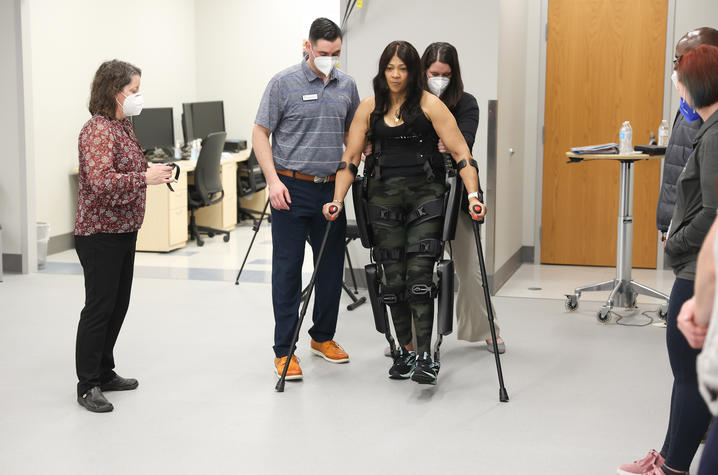

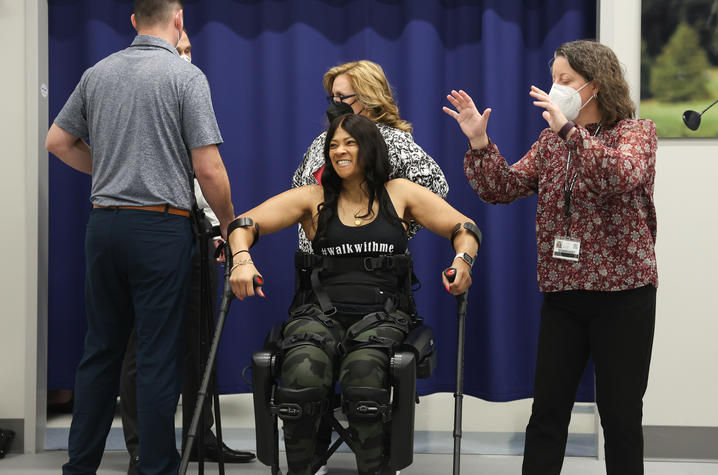
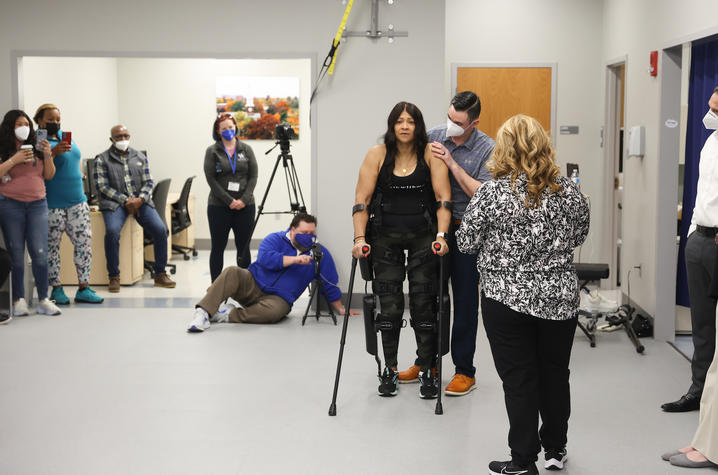
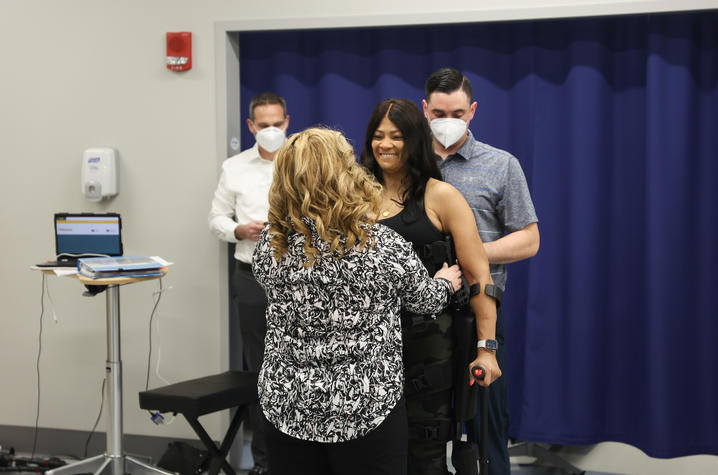
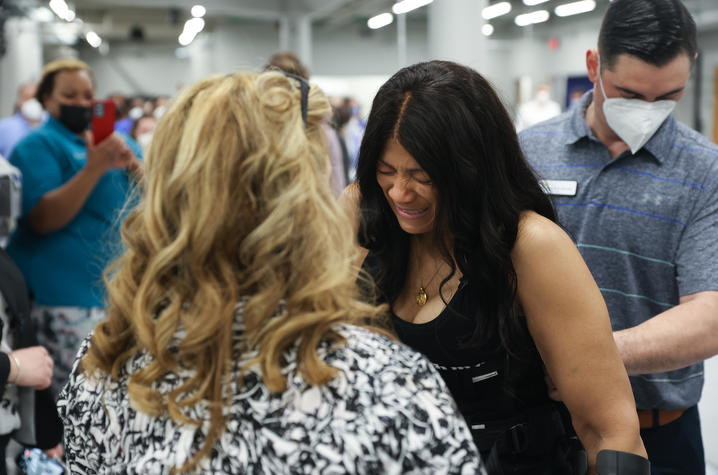
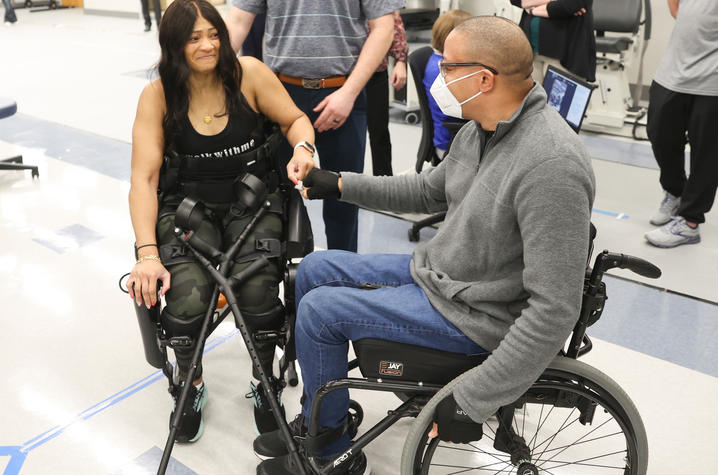
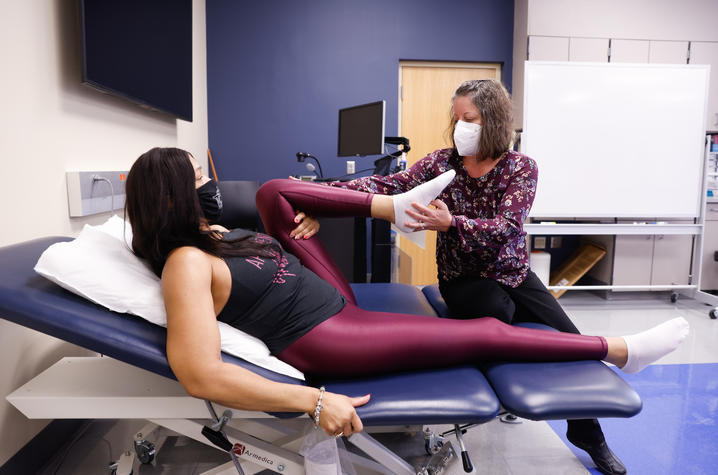
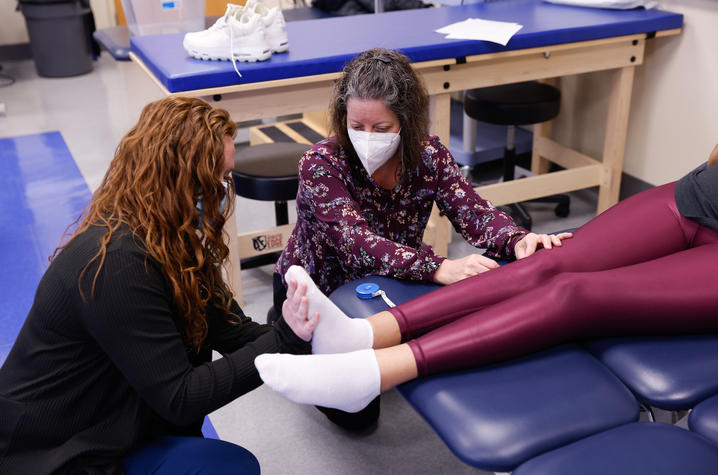
As the state’s flagship, land-grant institution, the University of Kentucky exists to advance the Commonwealth. We do that by preparing the next generation of leaders — placing students at the heart of everything we do — and transforming the lives of Kentuckians through education, research and creative work, service and health care. We pride ourselves on being a catalyst for breakthroughs and a force for healing, a place where ingenuity unfolds. It's all made possible by our people — visionaries, disruptors and pioneers — who make up 200 academic programs, a $476.5 million research and development enterprise and a world-class medical center, all on one campus.




